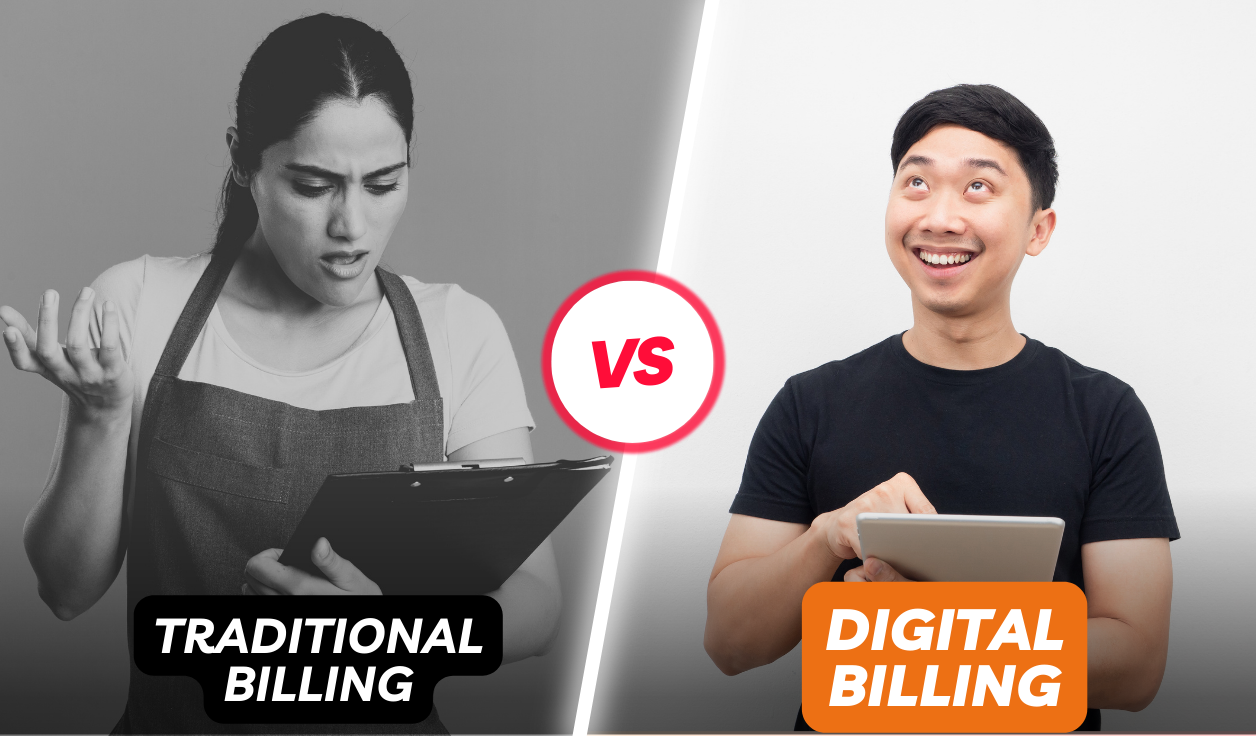Comparing Traditional and Digital Billing Methods: Paper Vs. Digitize

Running a successful restaurant, keeping up with the times is essential. One facet that has witnessed a transformation shift is billing and invoicing. The longstanding practice of paper invoices is steadily giving way to advanced POS billing software. In this exploration, we'll dissect these two methods, pinpoint the issues they address, and uncover how adopting POS software can distinctly revolutionize your restaurant business.
What is Traditional Billing?
Traditional billing involves generating paper-based invoices and managing financial transactions using physical documentation. Invoices are printed on paper, containing details like product descriptions, prices, and payment terms, often leading to errors, delivery delays, and environmental impact.
What is Digital Billing?
Digital billing is a modern approach where electronic invoices are created using software or online platforms, sent via email, and processed digitally. This method eliminates paper usage, reduces errors, accelerates delivery, and enables real-time tracking of payment status, aligning with the efficiency and speed of the digital age.
The Traditional Pain Points:
Manual Errors:
Paper invoices are prone to human errors, both in calculation and data entry. These errors can lead to misunderstandings and disputes with customers, tarnishing your business's reputation.
Time-Consuming:
Preparing, printing, and mailing paper invoices is a time-consuming process. It adds unnecessary delays to the billing cycle and affects cash flow.
Limited Accessibility:
Paper invoices are location-bound. Accessing past invoices or updating billing information requires sifting through physical documents, making collaboration and record-keeping cumbersome.
Environmental Impact:
The environmental toll of paper invoices cannot be ignored. The resources used in paper production and the carbon footprint of shipping paper documents contribute to ecological concerns.
Transformation with POS Software:
Automation and Accuracy:
POS billing software eliminates manual errors by automating calculations and data entry. This ensures that each invoice is accurate, reducing disputes and enhancing customer satisfaction.
Time Efficiency:
With POS software, generating invoices is a matter of a few clicks. This expedites the billing process, improving cash flow and allowing your team to focus on more strategic tasks.
Enhanced Accessibility:
POS software offers cloud-based solutions that enable access to invoices from anywhere with an internet connection. This facilitates collaboration among teams and grants customers easy access to their billing history.
Sustainability:
By transitioning from paper to digital invoices, you contribute to a more sustainable business environment. Reducing paper usage and carbon emissions associated with transportation aligns your business with eco-conscious practices.
Analytics and Insights:
POS software often comes equipped with analytical tools. These tools provide insights into sales trends, customer behaviors, and inventory management, aiding informed decision-making for your business's growth.
Customer Convenience:
POS software allows various payment options, including credit/debit cards, mobile wallets, and online transfers. This convenience can lead to quicker payments and improved customer relationships.
Security:
Paper invoices can be easily lost or tampered with. POS software offers encryption and data security measures, ensuring the confidentiality and integrity of your financial transactions.
Making the Transition:
Embarking on the journey from traditional paper invoices to POS software might appear overwhelming, but it's a crucial stride towards modernizing your business operations. Here's a guide to facilitate a seamless transition:
Research:
Begin by delving into the diverse array of POS software options accessible in the market. Pay close attention to features that harmonize with the specific needs of your business.
Inventory Management:
Incorporate your inventory management processes into the transition plan. Ensure that the chosen POS software efficiently handles inventory tracking, updates, and alerts to streamline operations.
Customer Support:
As you switch to POS software, consider how it can enhance customer support. Look for features that enable easy access to transaction histories, allowing your support team to provide quick and accurate assistance to customers.
Integration:
If your business already employs accounting or inventory management
systems, it's pivotal to select POS software that seamlessly integrates
with these systems. This integration ensures a cohesive flow of
information across various facets of your business.
Transitioning from traditional practices to modern solutions requires
careful planning and execution. By embracing the opportunities offered
by POS software, you're not only simplifying your invoicing processes
but also positioning your business for enhanced growth and efficiency.
In Conclusion
The evolution from traditional paper invoices to POS billing software signifies a leap towards operational excellence. The advantages of automation, accuracy, and accessibility are paramount in an increasingly digital business world. By addressing the pain points of the past, businesses can ensure a smoother billing process, satisfied customers, and a positive impact on the environment. Embracing this transformation is not just a choice; it's a strategic move to secure your business's future.